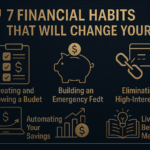
Managing money wisely isn’t just about earning more—it’s about building habits that lead to financial stability and peace of mind. Good financial habits can transform your life by reducing stress, helping you achieve your goals, and securing your future. Whether you’re struggling with debt, living paycheck to paycheck, or simply looking to grow your wealth, adopting the right habits can make all the difference. These habits are not about quick fixes; they’re about consistent, intentional actions that compound over time. Imagine having an emergency fund for unexpected expenses, paying off debt faster, or saving enough for a dream vacation or retirement. By embracing financial discipline and practical money management strategies, you can take control of your finances and build a brighter future. In this article, we’ll explore seven powerful financial habits that anyone can adopt to achieve financial stability and long-term success.
- 1 Key Takeaways
- 2 Habit 1: Create and Stick to a Budget
- 3 Habit 2: Build an Emergency Fund
- 4 Habit 3: Pay Off High-Interest Debt
- 5 Habit 4: Save Before You Spend
- 6 Habit 5: Track Your Spending
- 7 Habit 6: Invest for the Future
- 8 Habit 7: Educate Yourself About Finances
- 9 Comparison Table: Good vs. Bad Financial Habits
- 10 Implementation Guide: How to Start These Habits
- 11 Overcoming Financial Setbacks
- 12 Conclusion
- 13 FAQ
Key Takeaways
- Learn how to create a realistic budget and stick to it.
- Understand the importance of an emergency fund for financial security.
- Discover strategies to pay off high-interest debt quickly.
- Master the habit of saving before spending to build wealth.
- Track spending to identify and eliminate wasteful habits.
- Start investing early to grow your money over time.
- Continuously educate yourself to make informed financial decisions.
Habit 1: Create and Stick to a Budget
Explanation
A budget is the foundation of financial discipline. It’s a plan that outlines how much you earn, spend, and save each month. By creating a budget, you gain clarity on where your money goes and ensure you’re living within your means. A well-structured budget helps you prioritize essential expenses, avoid overspending, and allocate funds toward savings and debt repayment.
Practical Tips
- Use the 50/30/20 Rule: Allocate 50% of your income to needs (housing, utilities), 30% to wants (entertainment, dining out), and 20% to savings or debt repayment.
- Choose a Budgeting Tool: Apps like Mint, YNAB, or a simple spreadsheet can help you track income and expenses.
- Review Weekly: Check your budget weekly to stay on track and adjust as needed.
- Set Realistic Goals: If dining out is a big expense, don’t eliminate it entirely—reduce it gradually.
Benefits
- Reduces financial stress by giving you control over your money.
- Helps you save for big goals like a house, car, or vacation.
- Prevents overspending and keeps debt in check.
Example
Sarah, a 30-year-old teacher, struggled with overspending on clothes and dining out. She created a budget using the 50/30/20 rule, allocating $1,500 of her $3,000 monthly income to needs, $900 to wants, and $600 to savings and debt repayment. By reviewing her budget weekly, she cut unnecessary expenses and saved $2,000 for a vacation within a year.
Habit 2: Build an Emergency Fund
Explanation
An emergency fund is a savings account reserved for unexpected expenses, like medical bills or car repairs. It acts as a financial safety net, preventing you from relying on credit cards or loans during emergencies. Experts recommend saving 3–6 months’ worth of living expenses.
Practical Tips
- Start Small: Save $500–$1,000 as an initial goal, then aim for 3–6 months of expenses.
- Automate Savings: Set up automatic transfers to a high-yield savings account.
- Cut One Expense: Skip one coffee shop visit per week to add $20–$30 monthly to your fund.
- Keep It Accessible: Store your emergency fund in a separate, easily accessible account.
Benefits
- Protects you from financial crises without derailing your budget.
- Reduces reliance on high-interest debt during emergencies.
- Provides peace of mind and financial security.
Example
John, a freelance designer, faced a $1,200 car repair bill. Thanks to his $2,000 emergency fund, he paid for it without stress or borrowing. Without the fund, he would have used a credit card, adding interest to his expenses.
Habit 3: Pay Off High-Interest Debt
Explanation
High-interest debt, like credit card balances, can drain your finances due to compounding interest. Paying it off quickly frees up money for savings and investments. The debt avalanche method (paying off high-interest debt first) or debt snowball method (paying off smallest debts first) are effective strategies.
Practical Tips
- List All Debts: Write down balances, interest rates, and minimum payments.
- Choose a Strategy: Use the avalanche method to save on interest or the snowball method for quick wins.
- Pay More Than the Minimum: Allocate extra funds to your highest-priority debt.
- Negotiate Rates: Call creditors to request lower interest rates.
Benefits
- Saves money on interest payments.
- Improves your credit score.
- Frees up income for other financial goals.
Example
Lisa had $10,000 in credit card debt at 18% interest. Using the debt avalanche method, she paid $500 monthly toward the highest-interest card while making minimum payments on others. Within two years, she was debt-free, saving thousands in interest.
Habit 4: Save Before You Spend
Explanation
The “pay yourself first” principle means prioritizing savings before spending on non-essentials. By treating savings like a bill, you ensure consistent progress toward financial goals, such as retirement or a down payment.
Practical Tips
- Automate Savings: Set up automatic transfers to savings or investment accounts on payday.
- Set Specific Goals: Save for a house, retirement, or a dream vacation to stay motivated.
- Start Small: Even $50 per month adds up over time.
- Use Separate Accounts: Create accounts for different goals (e.g., travel, emergency fund).
Benefits
- Builds wealth steadily over time.
- Reduces temptation to overspend.
- Helps achieve short- and long-term goals.
Example
Mark, a 25-year-old engineer, automated $200 monthly transfers to a retirement account. By age 35, his contributions grew to $30,000 with compound interest, setting him on track for a comfortable retirement.
Habit 5: Track Your Spending
Explanation
Tracking spending helps you understand your financial habits and identify areas to cut back. It’s like a fitness tracker for your wallet, revealing patterns you may not notice otherwise.
Practical Tips
- Use an App: Apps like PocketGuard or EveryDollar simplify expense tracking.
- Review Daily: Spend 5 minutes daily logging expenses or checking your app.
- Categorize Spending: Group expenses into categories like groceries, entertainment, and utilities.
- Set Alerts: Use banking apps to notify you when you’re close to overspending.
Benefits
- Identifies wasteful spending habits.
- Keeps you accountable to your budget.
- Helps you make informed financial decisions.
Example
Emma noticed she spent $300 monthly on takeout by tracking her expenses. She reduced it to $100, redirecting the $200 savings to her emergency fund, which grew to $1,000 in five months.
Habit 6: Invest for the Future
Explanation
Investing allows your money to grow over time through compound interest or market gains. Starting early, even with small amounts, can lead to significant wealth. Options include retirement accounts, stocks, or low-cost index funds.
Practical Tips
- Start with Retirement Accounts: Contribute to a 401(k) or IRA, especially if your employer matches contributions.
- Diversify Investments: Spread money across stocks, bonds, and real estate to reduce risk.
- Start Small: Invest as little as $25 monthly in a robo-advisor or index fund.
- Stay Consistent: Invest regularly, regardless of market fluctuations.
Benefits
- Builds long-term wealth for retirement or major goals.
- Outpaces inflation, preserving your money’s value.
- Creates passive income streams over time.
Example
At age 30, Alex invested $100 monthly in an index fund with an 8% annual return. By age 60, his investment grew to over $150,000, thanks to compounding.
Habit 7: Educate Yourself About Finances
Explanation
Financial literacy empowers you to make informed decisions about budgeting, investing, and debt. The more you learn, the better equipped you are to avoid scams, choose smart investments, and plan for the future.
Practical Tips
- Read Books: Start with “The Total Money Makeover” by Dave Ramsey or “Rich Dad Poor Dad” by Robert Kiyosaki.
- Follow Blogs/Podcasts: Websites like NerdWallet or podcasts like “The Money Guy Show” offer practical advice.
- Take Free Courses: Platforms like Coursera or Khan Academy offer free financial literacy courses.
- Stay Updated: Follow financial news to understand market trends.
Benefits
- Improves decision-making and confidence.
- Helps avoid costly financial mistakes.
- Enables you to teach others, like family or friends.
Example
Tina, a single mom, learned about investing through a free online course. She opened a Roth IRA and started contributing $50 monthly, ensuring a more secure future for her family.
Comparison Table: Good vs. Bad Financial Habits
| Habit | Good Financial Habit | Bad Financial Habit | Financial Impact |
|---|---|---|---|
| Budgeting | Creates and follows a monthly budget | Spends without a plan | Good: Saves money, reduces stress; Bad: Leads to overspending, debt |
| Emergency Fund | Saves 3–6 months of expenses | No savings for emergencies | Good: Financial security; Bad: Relies on debt for emergencies |
| Debt Management | Pays off high-interest debt quickly | Makes only minimum payments | Good: Saves on interest; Bad: Accumulates high interest costs |
| Saving | Saves before spending | Spends all income | Good: Builds wealth; Bad: No savings for goals |
| Spending Tracking | Tracks daily expenses | Ignores spending patterns | Good: Identifies savings opportunities; Bad: Overspends unknowingly |
| Investing | Invests regularly for the future | Doesn’t invest | Good: Grows wealth; Bad: Misses compound interest |
| Financial Education | Continuously learns about money | Ignores financial education | Good: Makes informed decisions; Bad: Falls for scams, poor choices |
Implementation Guide: How to Start These Habits
Adopting new financial habits can feel overwhelming, but starting small and staying consistent is key. Here’s a step-by-step guide:
- Start with a Budget: Spend one hour creating a simple budget using the 50/30/20 rule. Use a free app like Mint to track it.
- Set Up an Emergency Fund: Open a high-yield savings account and automate $25–$50 monthly transfers.
- Tackle One Debt: List your debts and focus extra payments on the highest-interest one.
- Automate Savings: Set up a $10–$50 automatic transfer to a savings account on payday.
- Track Spending for One Week: Use a notebook or app to log every expense for seven days to identify patterns.
- Start Investing Small: Open a robo-advisor account and invest $25 monthly in a low-cost fund.
- Learn One Topic Weekly: Spend 30 minutes each week reading a financial article or listening to a podcast.
- Review Monthly: Set a monthly date to review your budget, savings, and progress.
Consistency is more important than perfection. Start with one or two habits and add more as you gain confidence.
Overcoming Financial Setbacks
Financial setbacks, like job loss or unexpected medical bills, can derail even the best plans. Here’s how to handle them:
- Revisit Your Budget: Cut non-essential expenses, like subscriptions, to free up cash.
- Use Your Emergency Fund: That’s what it’s for! Rebuild it once the crisis passes.
- Communicate with Creditors: Many offer payment plans or reduced rates during hardships.
- Seek Side Income: Freelance, sell unused items, or take a part-time job to cover gaps.
- Stay Positive: Setbacks are temporary. Focus on small steps to recover.
For example, when Maria lost her job, she used her emergency fund to cover rent, paused dining out, and took a freelance gig. Within three months, she was back on track.
Conclusion
Building financial discipline through these seven habits—budgeting, saving, debt repayment, tracking spending, investing, and continuous learning—can transform your financial future. These habits aren’t about deprivation; they’re about creating freedom and security. Start small, stay consistent, and watch your financial stress fade as your savings grow. Imagine the peace of mind that comes with an emergency fund, no high-interest debt, and investments working for you. Take the first step today—whether it’s creating a budget or saving $10 a week. Over time, these habits will compound, leading to financial stability and the ability to achieve your dreams. Commit to these changes, and you’ll not only transform your finances but also gain confidence and control over your life.
FAQ
1. Why is a budget important for financial success?
A budget helps you control your spending, prioritize savings, and avoid debt, ensuring you live within your means.
2. How much should I save in an emergency fund?
Aim for 3–6 months of living expenses, starting with a smaller goal of $500–$1,000.
3. What’s the best way to pay off debt?
Use the debt avalanche (highest interest first) or snowball (smallest balance first) method, depending on what motivates you.
4. How can I start investing with little money?
Start with low-cost options like robo-advisors or index funds, investing as little as $25 monthly.
5. How do I stay motivated to track my spending?
Use apps to make tracking easy, and reward yourself with small treats for sticking to your budget.
6. What if I face a financial setback?
Use your emergency fund, cut non-essentials, and explore side income to recover quickly.
7. Where can I learn more about personal finance?
Read books like “The Total Money Makeover,” follow blogs like NerdWallet, or take free online courses.


